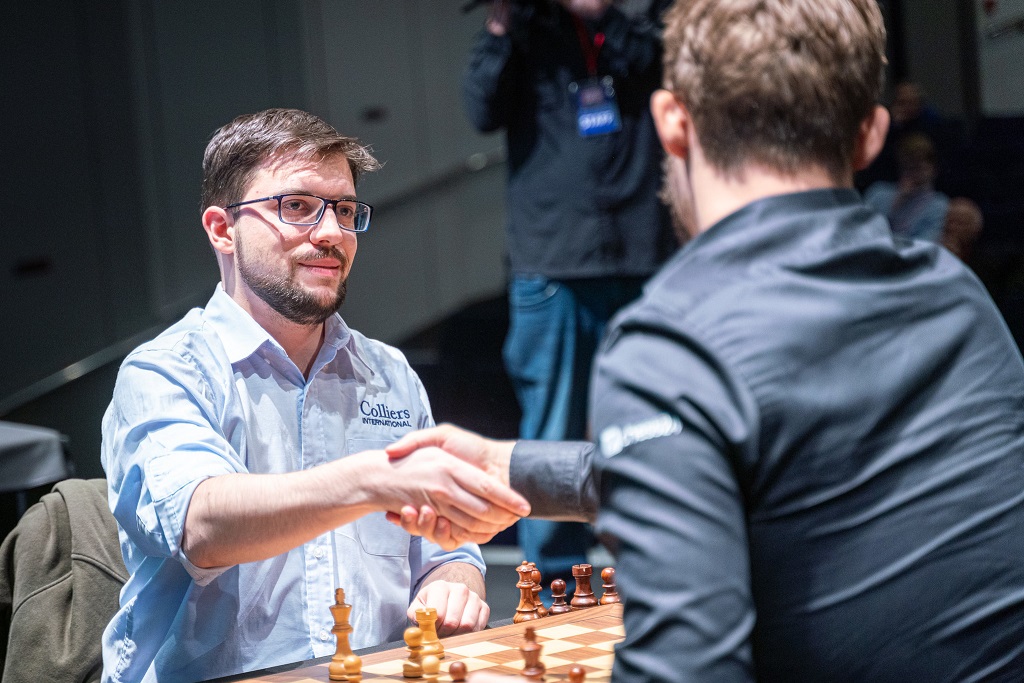


Epyllia, or little epics, are brief narrative poems, usually dealing with mythological and romantic themes. The Vachier-Lagrave v Carlsen semi-final was repeatedly and rightfully described as an epic battle during the live commentary webcast, but one of the many attractive games of the match stood out for its dramatic content — an epyllion, we might say.
'MVL' scored the first win of the match in the second (of four) blitz encounters. Carlsen bounced right back, and a draw in the final game of 'regulation' meant the duel would be decided on playoffs. The players repeated the line of the Najdorf that had resulted in a memorable draw at the outset of the match. First Vachier-Lagrave and then Carlsen missed chances to convert clearly superior positions, but the world champion was the one making the last mistake. After the thoroughly painful loss, the Norwegian could not bounce back again.
Thus, Vachier-Lagrave obtained his pass to the final. He will face Ding Liren, who kicked off the day with two wins over Levon Aronian — a draw in the first blitz game already gave the Chinese match victory.
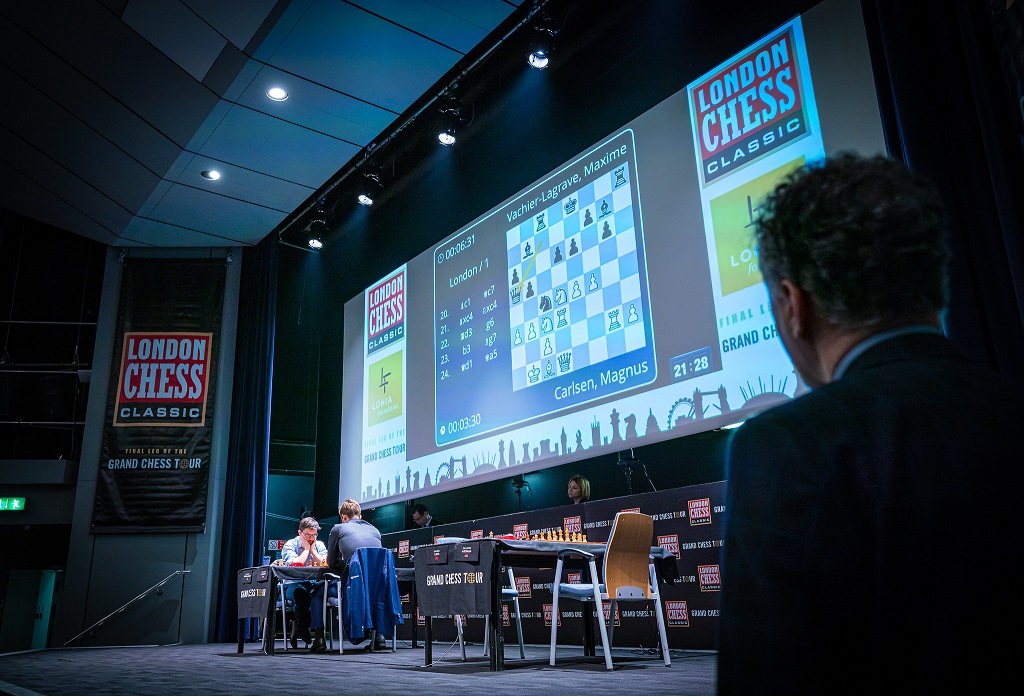
The stage at the Olympia Conference Centre | Photo: Lennart Ootes / Grand Chess Tour
Vachier-Lagrave's white games during the match saw the players exploring lines of the Ruy Lopez or the Sicilian, depending on whether Carlsen needed to win on demand or not. On the other hand, when the world champion was the one moving first, the range of setups explored was wider. After a rather tense draw in the first game of rapid, Carlsen put Vachier-Lagrave's Grünfeld to the test. He gained a pawn, but that never amounted to much:
Vachier-Lagrave simplified into a rook and knight versus rook endgame — a theoretical draw — with 58...♝xf3+. Thus, the score remained tied after the rapid section.
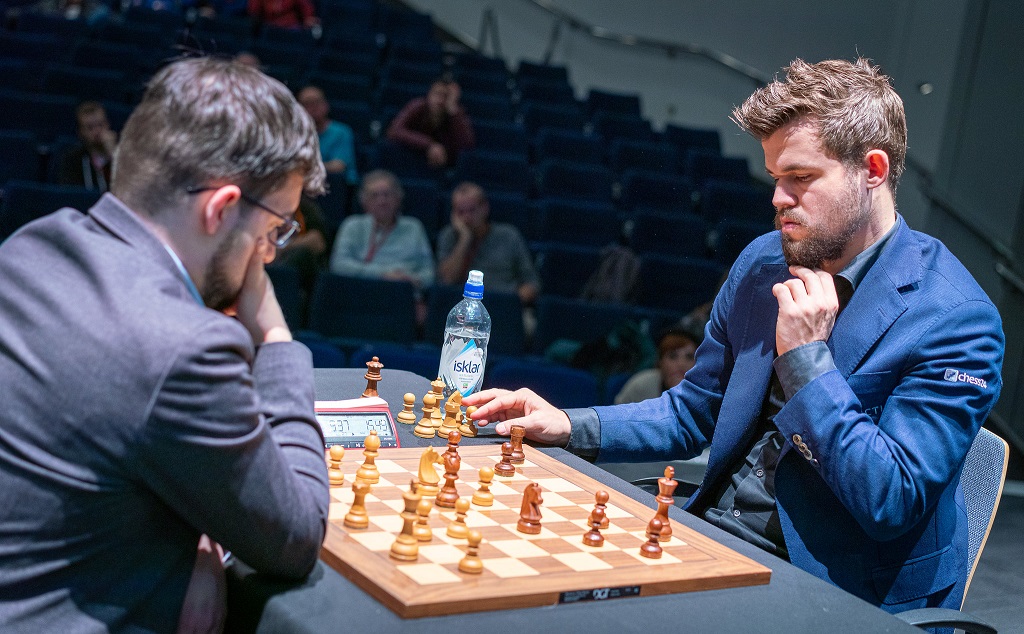
The match remained drawn after the rapid phase | Photo: Lennart Ootes / Grand Chess Tour
France's number one had the white pieces first in the blitz. The players delved into the line that gave Carlsen a favourable position in the second classical encounter, except this time Vachier-Lagrave was better prepared.
The Frenchman gave up an exchange on move 17, but Black's weakened king position was the critical factor in the middlegame. Four moves later, the world champion offered to give back the exchange, and Vachier-Lagrave incorrectly accepted to restore material equality. On move 28, Carlsen made a pragmatic decision:
The world champion gave up a pawn with 28...e3 in order to leave the e4-square vacant for his bishop. Converting the slight edge with little time on the clock proved to be out of reach for Vachier-Lagrave, and the game did not take long to peter out into a draw.
In game two of the 5-minute section, Carlsen chose a non-forcing line with the white pieces. When only rooks, bishops and pawns were left on the board, Black seemed to be for choice, but the perceived advantage was very slim. The world champion confidently traded down into a pure rook endgame:
At this point, Carlsen played the natural-looking 35.♖b5, when after 35...♜c2+ White needs to escape from the check with 36.♔f3, placing the king on a sub-optimal square. In the diagrammed position, 35.e4 was the way to go, opening up the e3-square for White's monarch. This small detail was what eventually gave Vachier-Lagrave the first victory of the match. Carlsen now needed to win one of the two remaining games to stay in contention...
...and he delivered, after taking advantage of a strategical mistake by his opponent:
Exchanging the bishop for the knight with 16.♗xf6 turned out to be a crucial mistake. Black captured with the pawn, established a structure with pawns on f5-e6-f7, and went on to prove his dark-squared bishop was the stronger minor piece. Carlsen's conversion was exemplary. The match was now drawn and there was one more blitz game left to go.
In the fourth 5-minute encounter of the day, Carlsen got a small edge with his passer on the c-file, but a correct defensive effort by his rival led to a 77-move draw.
The match was set to be decided on playoffs. The tied score would need to be broken with two 10-minute games (with 5-second delays) — if the draw continued, an Armageddon encounter would conclude the match.
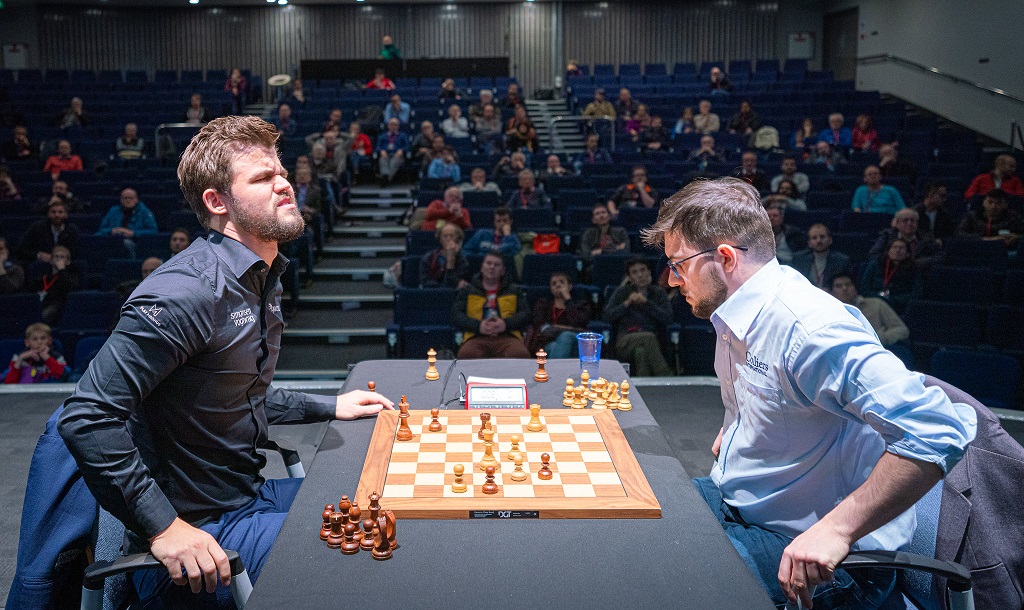
Carlsen frustrated after losing a holdable endgame | Photo: Lennart Ootes / Grand Chess Tour
The first playoff encounter was the highlight of the day. Carlsen later declared that he went into the Najdorf — his rival's pet opening — because he trusted the idea he had used in the first classical game of the match. With both kings vulnerable to direct attacks, Carlsen was the first one to put a foot wrong (only to see his opponent blunder immediately afterwards):
Carlsen had just played 25.f5 in a wild position (25.♘xe6 was a strong shot, spotted by Peter Svidler in the commentary room), giving Vachier-Lagrave the chance to play 25...exf5, when Black's threats are difficult to parry. But the Frenchman opted for 25...♞e5 instead. Carlsen responded with 26.b4, and White had managed to expel Black's two strongest attacking pieces from their menacing spots on the queenside.
The world champion had an overwhelming advantage soon after. The Norwegian missed some lethal opportunities in the ensuing complications, but he did not quite give up his advantage until disaster struck on move 35:
Exchanging on d8 or preparing to infiltrate with the queen via c1 or e1 were all good alternatives here, while 35.♘c5 was perhaps the one 'playable' move that allowed Black to get back to contention. Vachier-Lagrave found 35...♜xd3 36.♘xd3 ♞xa3+ immediately and went on to get the upper hand after Carlsen faltered again with 37.♔c1.
'MVL' was now in the driver's seat. The French grandmaster made some mistakes later on, but Carlsen was visibly frustrated and failed to find the most resilient defensive resources. Eventually, a knight endgame with Black having two pawns to White's none emerged. Carlsen finally resigned on move 82.
Vachier-Lagrave had White in the rematch, and handled the situation with admirable self-composure. Despite getting a very favourable position, he settled for an equal endgame when given a chance. A 44-move draw gave him a ticket to the final.

MVL thanked his friends for their support | Photo: Lennart Ootes / Grand Chess Tour
Carlsen later confessed he did not feel quite in shape from the start of the day:
To be honest, I felt pretty early on that this wasn't really my day. I just felt really, really sluggish. I think he missed some chances to put the match away. [...] I was just not good enough in the critical moments
Vachier-Lagrave, in turn, declared that he was pretty tired, but the support from his French friends encouraged him to keep fighting. Naturally, defeating Carlsen is a great achievement, but he has something else in mind:
This is not my main priority. Of course it's a great pleasure to be here, and of course I'm playing to win the event, but for me it's mostly about going to the Candidates.
The Frenchman was referring to the fact that he will be fighting to get a spot in the Candidates at the upcoming Grand Prix event in Jerusalem. After barely missing to qualify in the previous cycle, he is once again in danger of falling barely short (he already struck out at the World Cup).
Although both semi-final matches reached the rapid stage with the score tied, they took drastically different paths on Wednesday. While the tension kept rising between Carlsen and Vachier-Lagrave, Ding Liren had all but secured victory in the first two encounters of the day. The Chinese star went for a remarkable piece sacrifice early on:
White played 17.♘g5, giving up the d5-knight in exchange for a strong initiative. The move is approved by the engines, and probably finding it during a classical game would not be surprising for a player of Ding's calibre...but doing it in a rapid game was a commendable feat, especially after hearing the Chinese explaining his thought process.
I think if I go back [with the knight], then at least he has a draw. Also I was short on time, so I wanted to play the most straightforward line, just moving forward.
Aronian was not lost by any means, but his pieces were awfully undeveloped, which only made things harder for him. The final blunder came on move 25:
The Armenian's 25...♛f7 allowed 26.♖c6, forcing the exchange of rooks. Black's minor pieces on c8 and d7 are sitting ducks. Ding had no issues converting this position into a win.
After Ding obtained another remarkable win in the second rapid game, Aronian won two and the Chinese won one in the blitz section. However, after the draw in the first 5-minute game Ding had already secured match victory. He told Maurice Ashley:
After yesterday's games I [thought] I should play better than yesterday, but I didn't expect things to go so well.
Meanwhile, the Armenian did not lose his sense of humour:
MA: Good luck in the consolation match.
LA: In the losers' match...
MA: You said it (laughs).
The players will have a rest day on Thursday, when they will be paired with entrepreneurs in friendly games to raise money for the Chess in Schools and Communities charity organization. The final and the match for third place will kick off on Friday.
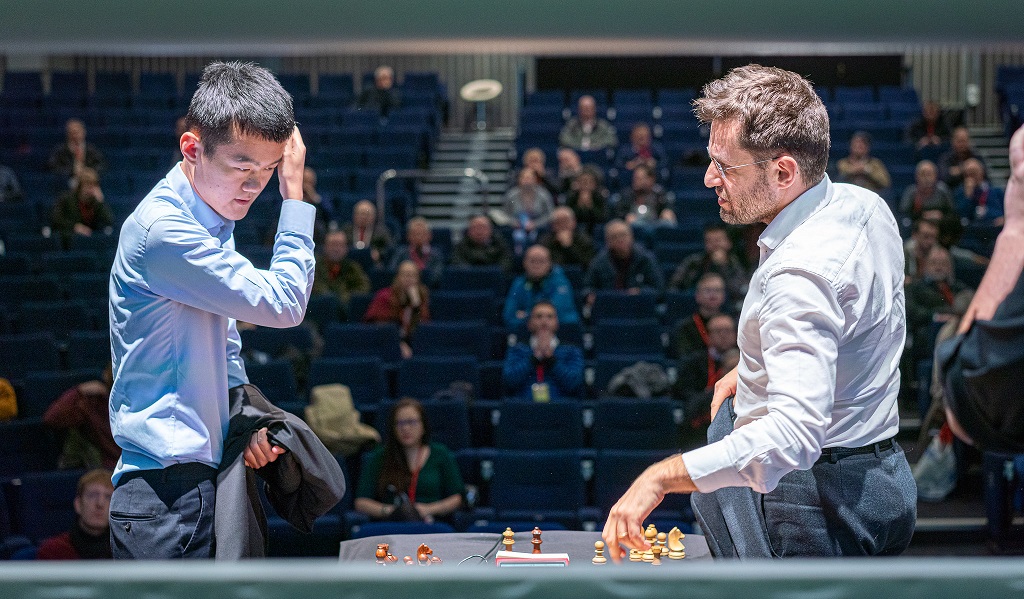
Ding Liren and Levon Aronian | Photo: Lennart Ootes / Grand Chess Tour
Commentary by Jennifer Shahade, Peter Svidler, Alejandro Ramirez and Maurice Ashley
Times in UTC.
| Date/Time | Event | Round |
|---|---|---|
| December 2, 16:00 | Carlsen vs Vachier-Lagrave Aronian vs Ding |
Semi-final, Game 1 |
| December 3, 16:00 | Vachier-Lagrave vs Carlsen Ding vs Aronian |
Semi-final, Game 2 |
| December 4 | Semi-finals Rapid & Blitz | 3-8 |
| 16:00 | Rapid | Game 1 |
| 17:30 | Rapid | Game 2 |
| 19:00 | Blitz | Game 1 |
| 19:30 | Blitz | Game 2 |
| 20:00 | Blitz | Game 3 |
| 20:30 | Blitz | Game 4 |
| 21:15 | Playoff | (If necessary) |
| December 5 | Pro Biz Cup | |
| December 6, 16:00 | Final | Classical Game 1 |
| December 7, 14:00 | Final | Classical Game 1 |
| December 8 | Final Rapid & Blitz | |
| 14:00 | Rapid | Game 1 |
| 15:30 | Rapid | Game 2 |
| 17:00 | Blitz | Game 1 |
| 17:30 | Blitz | Game 2 |
| 18:00 | Blitz | Game 3 |
| 18:30 | Blitz | Game 4 |
| 19:15 | Playoff | (If necessary) |
Closing ceremony to follow
6 points for a win, 3 points for a draw and 0 points for a loss in the two Classic games
4 points for a win, 2 points for a draw and 0 points for a loss in the two Rapid games
2 points for a win, 1 point for a draw 0 points for a loss in the four blitz games